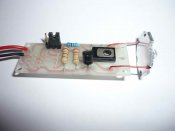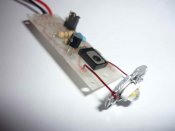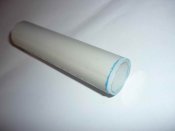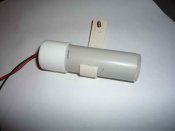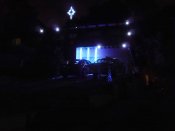I have posted some pictures of the 3W LED Strobes that I built this year. I made these for a cost of around $3.10 each.
The enclosure is a 80mm long piece of standard 25mm electrical conduit. The "lense" end is cut from 3mm perspex using a hole saw in a drill press. Take out the centre drill from the hole saw so you dont get a hole in the middle of your lense. Without the centre drill you need a drill press to control the hole saw and clamp the perspex down as well to stop it moving. The other end is a 25mm chair tip with a small hole drilled for the wires to exit. The perspex 'lense" is glued on with either PVC cement (plumbers glue), or super glue. I used both and didnt notice much difference. Neither glue failed. The "bracket" was made by slicing 90mm storm water pipe into strips and using a heat gun to flatten the plastic and bend the plastic into a J shape. It was glued on with more PVC cement.
My strobes were under cover, but if exposed to weather I would recommend a drop of silicone to seal the hole where the wires exit through the chair tip. Depending on how straight the PVC is cut, a smear of silicone around the edge of the clear end would also be useful to ensure that no water gets in.
The LED is a 3W luxeon/star type LED from Aliexpress. The LED driver circuit consists of a current limiter and is based on circuits is found on the various Xmas lights forums (see ACL Strobes), with a few customisations to suit my needs - although I never used them. The unit shown is a "dumb" unit and was turned on and off via vixen. I did allow provision for a PIC to be fitted on the PCB for a true strobe effect but never bothered to fit the PICs and used vixen instead.
The last image shows the strobes in operation.
NOTE (very important) there is no heat sink for the LED. The strobe is fine for imtermittent operation, but if it were run continuously, or with a high duty cycle a heat sink is needed. This design doesn't provide for a heat sink. The 3W LED gets quite hot in continuous operation and I did melt one when I left it on accidentally.
The enclosure is a 80mm long piece of standard 25mm electrical conduit. The "lense" end is cut from 3mm perspex using a hole saw in a drill press. Take out the centre drill from the hole saw so you dont get a hole in the middle of your lense. Without the centre drill you need a drill press to control the hole saw and clamp the perspex down as well to stop it moving. The other end is a 25mm chair tip with a small hole drilled for the wires to exit. The perspex 'lense" is glued on with either PVC cement (plumbers glue), or super glue. I used both and didnt notice much difference. Neither glue failed. The "bracket" was made by slicing 90mm storm water pipe into strips and using a heat gun to flatten the plastic and bend the plastic into a J shape. It was glued on with more PVC cement.
My strobes were under cover, but if exposed to weather I would recommend a drop of silicone to seal the hole where the wires exit through the chair tip. Depending on how straight the PVC is cut, a smear of silicone around the edge of the clear end would also be useful to ensure that no water gets in.
The LED is a 3W luxeon/star type LED from Aliexpress. The LED driver circuit consists of a current limiter and is based on circuits is found on the various Xmas lights forums (see ACL Strobes), with a few customisations to suit my needs - although I never used them. The unit shown is a "dumb" unit and was turned on and off via vixen. I did allow provision for a PIC to be fitted on the PCB for a true strobe effect but never bothered to fit the PICs and used vixen instead.
The last image shows the strobes in operation.
NOTE (very important) there is no heat sink for the LED. The strobe is fine for imtermittent operation, but if it were run continuously, or with a high duty cycle a heat sink is needed. This design doesn't provide for a heat sink. The 3W LED gets quite hot in continuous operation and I did melt one when I left it on accidentally.


